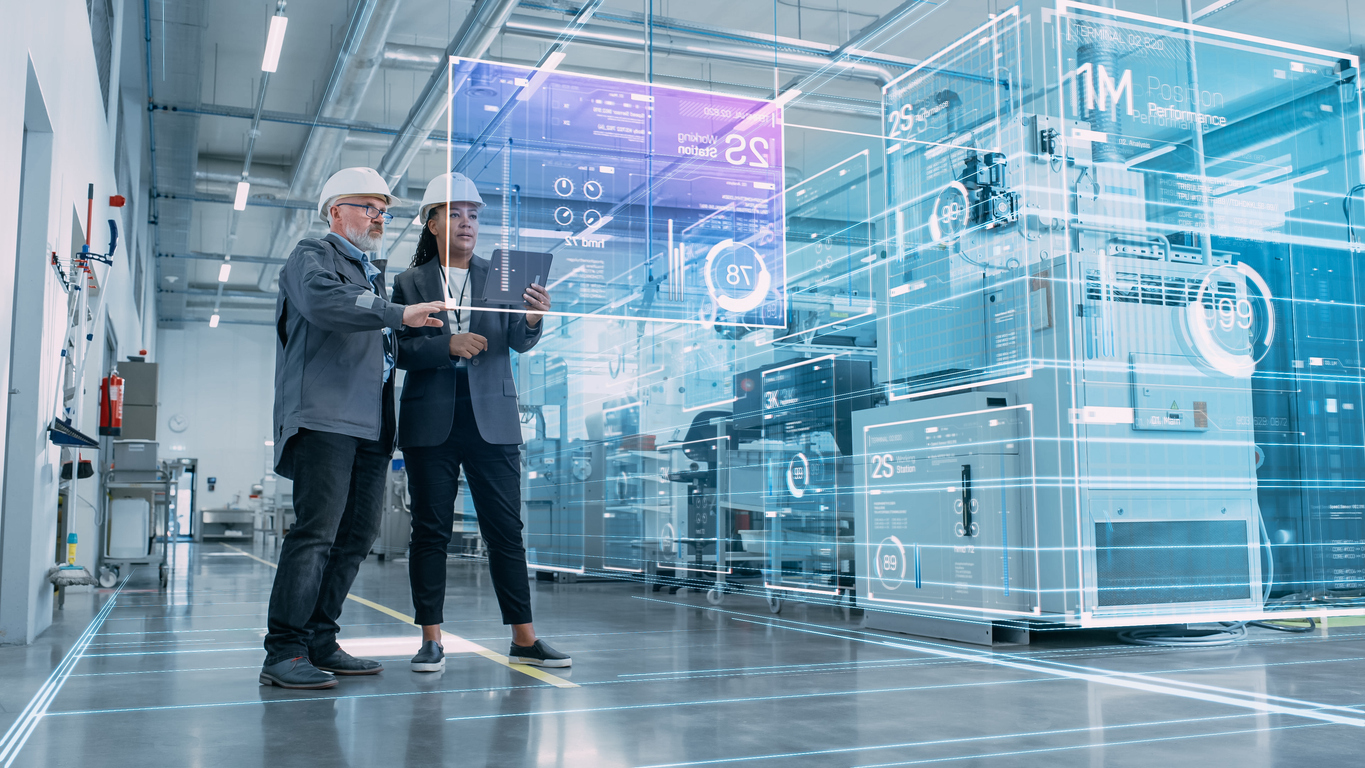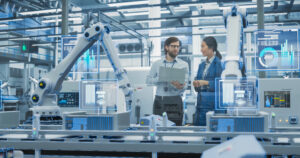Embracing the Future: How Manufacturing 4.0 is Transforming Industry
What is Manufacturing 4.0?
Also known as the Fourth Industrial Revolution, Manufacturing 4.0 integrates data with smart technology and automation to optimize production, supply chains, and create agility. With it, the pace of change in manufacturing is accelerating like never before. The term was coined by three German physicians and business leaders and first presented to the public at the Hannover Messe, the world’s largest trade fair for industrial development, in 2011. In the following year recommendations for its implementation were presented to the German government. Klaus Schwab, executive chairman of the World Economic forum introduced the phrase to a global audience in 2016 when “Mastering the Fourth Industrial Revolution” was adopted as the theme for the WEF annual meeting at Davos.
Defining what Manufacturing 4.0 contains is not so straightforward. It embraces a range of technologies such as artificial intelligence, robotics, augmented reality, real-time data analytics and the internet of things (IoT). The speed with which these technologies have been developed and implemented is staggering when we compare the fourth with the first three industrial revolutions and the changes they brought to manufacturing.
Manufacturing 1.0: Beginning in Great Britain around 1750 and spreading to continental Europe and the United States, the (First) Industrial Revolution saw the transition from manufacturing in the original sense (the making of products by hand) to mass production in factories using machines, typically powered by steam.
Manufacturing 2.0: The late 19th century and early 20th century saw a series of inventions and advancements in manufacturing technologies that rapidly expanded industrial output. Key features were the expansion of railroad networks, large-scale iron and steel production, greatly increased use of steam power, and the development of new energy sources such as petroleum and electricity. Perhaps the greatest symbol of this era was the mass production of automobiles like the Model T Ford on assembly lines.
Manufacturing 3.0: The Third Industrial Revolution, also known as the Digital Revolution, began in the second half of the 20th century. This period saw the implementation of systems based on transistors, circuit boards and microprocessors. Information systems revolutionized manufacturing, driving up productivity and reducing the manufacturing workforce in advanced countries such as the United States. Characteristic of this era was Moore’s Law, the observation that the number of transistors on a computer chip doubles every two years, with minimal cost increase. Digital systems became increasingly powerful and cheap, making digitalization all-pervasive.
The Technologies Behind Manufacturing 4.0
There are numerous technologies powering Manufacturing 4.0 but the main ones are the internet of things, artificial intelligence and machine learning, robotics and automation, big data and analytics, and edge computing.
The internet of things (IoT) refers to devices with sensors that communicate with each other via the Internet or other communication channels. In manufacturing the industrial internet of things (IIoT) can connect various devices equipped with sensing, identification, processing, communication, actuation, and networking capabilities, enabling the control and management of manufacturing equipment by people or machines via the network. When coupled with smart grids, IoT can also reduce energy consumption in manufacturing plants.
Artificial intelligence (AI) and machine learning (ML) techniques enable the generation of actionable intelligence by processing data to increase manufacturing efficiency. ML techniques can also provide predictive insights in a variety of manufacturing tasks such as intelligent and continuous inspection, predictive maintenance, quality improvement, process optimization, supply chain management, and task scheduling. Other AI technologies being used in Manufacturing 4.0 include computer vision, which teaches computers and systems to derive meaningful information from visual inputs, and natural language processing (NLP), which enables computers and digital devices to recognize, understand and generate text and speech.
Robotics that are used to do simple repetitive tasks with greater efficiency and accuracy than humans date back to Manufacturing 3.0. Robotic process automation (RPA) in manufacturing, by contrast, is the use of software robots (bots) to automate tasks like order processing, inventory management, and quality control. With advanced software such as AI agents, robots can also take decisions on when and how to perform certain tasks, bringing a higher level of automation.
Big data and analytics further differentiate Manufacturing 4.0 from the digitalization that preceded it. The volumes (and variety, variability and velocity) of data produced by sensors and production processes are simply too large or complex for the earlier generations of data processing software. New techniques such as parallel computing are required, and data is generally stored in the cloud. Big data can be highly complex, variable and is often generated and delivered at high speed. Analytics tools such as statistical analysis, forecasting, and predictive modeling are required to allow manufacturers to perform sophisticated assessments on historical plant floor data to optimize production processes.
Edge computing refers to the processing data closer to the source—such as sensors, machines, or devices—rather than relying on a centralized cloud or data center. This reduces latency, enhances real-time decision-making, and improves operational efficiency. Edge computing enables smart factories by supporting IIoT and automation with faster, localized data processing.
Smarter Production with Manufacturing 4.0
When these technologies are combined intelligently the result is smart factories—highly automated and digitally connected manufacturing facilities. They bring: increased efficiency as optimized workflows reduce waste and improve productivity; reduced downtime as predictive maintenance prevents costly machine failures; higher quality as AI-driven inspections and analytics enhance product consistency; greater flexibility as adaptive systems respond to changes in demand with minimal disruption; and cost savings. Automation and data-driven insights lead to better resource management in areas such as supply chain management.
By integrating edge computing, smart factories ensure faster, more reliable, and secure operations, even in environments where cloud connectivity is limited.
The Journey to Implementation
Despite its benefits, Manufacturing 4.0 is not without hurdles—chief among them, the massive investment required. Scaling up from pilot projects to full implementation often stalls due to financial constraints. Transitioning from traditional operations also raises significant challenges, particularly legacy systems and interoperability. Since Manufacturing 4.0 relies on data, integrating diverse datasets from various sources requires robust systems to harmonize information and extract meaningful insights.
The skills gap is another obstacle. Manufacturers must invest in training workers to operate new technologies. Researchers and technicians need upskilling to harness advanced systems, while shop floor employees must adapt to using tablets and touchscreens to interact with connected systems and refine production through data-driven insights. For instance, maintenance professionals in smart factories must move beyond routine schedules, learning to interpret real-time data and apply predictive maintenance techniques. Additionally, manufacturers must recruit specialists in robotics, digital twins, and analytics.
Infrastructure upgrades are often essential, requiring seamless integration of new and existing systems while minimizing operational disruptions. Cybersecurity is another concern; with countless sensors exchanging data, vulnerabilities to hacking and breaches increase. However, robust security standards, private networks, and modern cloud infrastructures with multi-layered defenses can mitigate these risks.
What Does the Future Hold for Manufacturing 4.0?
Manufacturing 4.0 is a work in progress, and we will see all of the technologies mentioned above evolving further and being more widely implemented. Here are a couple of future developments to look out for.
Digital twins are emerging as one of the most impactful industrial sector trends, offering exact virtual replicas of physical systems to enable real-time monitoring, simulation, and optimization. By replicating physical assets digitally, they provide a comprehensive view of operations, providing greater visibility and enabling informed decision-making.
Sustainability and the circular economy will shape the future of manufacturing industry, as companies increasingly adopt green practices to reduce environmental impact and align with global sustainability goals. From energy efficiency to waste reduction, Manufacturing 4.0 technologies are enabling more sustainable production processes and accelerating the shift toward carbon-neutral operations.
Autonomous commerce and supply chain automation, driven by AI agents, will enhance logistics, enabling agile, resilient supply chains that adapt quickly to market shifts while minimizing costs.
Conclusion
Like the first three industrial revolutions, Manufacturing 4.0 represents a major leap in industrial productivity, increasing output through automation and data-driven efficiency while optimizing human labor and material use. However, unlike previous revolutions, Manufacturing 4.0 enables a much higher degree of mass customization, allowing tailored products to be produced at scale with minimal added cost. It is also proceeding at unprecedented speed. The first industrial revolution took more than a century even in the most advanced countries.
If harnessed for the benefit of humanity as a whole, Manufacturing 4.0 could drive up standards of living in both industrialized and developing countries. Indeed, there is an opportunity for non-industrialized countries to leapfrog others with new purpose-built Manufacturing 4.0 plants.




